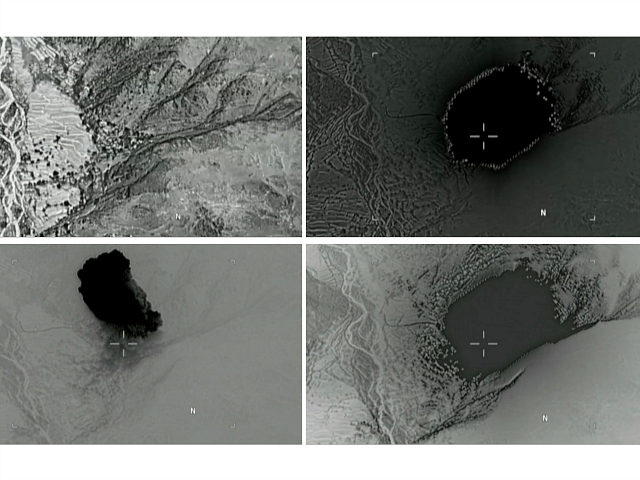The massive U.S. military strike on a network of tunnels along the Afghanistan-Pakistan border used by the local Islamic State (ISIS/ISIL) branch may have plugged the hole that allowed the flow of jihadi reinforcements from Pakistan into Afghanistan.
On Thursday, American Gen. John Nicholson, the top commander of U.S. and NATO troops in Afghanistan, reportedly ordered the U.S. military to drop the 21,600 pound GBU-43/B Massive Ordnance Air Blast bomb (MOAB) on an already weakened Afghan ISIS branch.
“This was the right weapon against the right target,” the general told reporters in Afghanistan Friday.
“Let me be clear — we will not relent in our mission to fight alongside our Afghan comrades to destroy ISIS-K in 2017,” he said, referring to ISIS’s regional wing known as the Khorasan Province (ISIS-K).
The strike, which took place in the Achin district of eastern Afghanistan’s Nangarhar province, marked the first time the colossal munition, known as the “mother of all bombs,” has been used in combat.
According to the U.S. military, the primary target of the GPS-guided bomb was a network of fortified underground tunnels that the terrorist group had been using to stage attacks on U.S.-backed Afghan forces and freely move back and forth across the Afghanistan-Pakistan border.
Achin lies along the international boundary between Afghanistan and Pakistan.
Most ISIS fighters in Afghanistan are Pashtuns from Pakistan, former members of the Pakistani Taliban or Tehreek-e-Taliban Pakistan (TTP), according to the Pentagon.
At the time of the strike, the American military believed the ISIS branch had been dramatically degraded, from a peak of 3,000 jihadis to between 600 and 800 ISIS fighters on the ground when the bomb was dropped, the vast majority of them in Nangarhar.
MOAB took out at least another 36 ISIS fighters and has significantly reduced the Islamic State’s ability to bring in reinforcements from Pakistan.
“The strike was designed to minimize risk to Afghan and U.S. Forces,” wrote the U.S. Department of Defense on Twitter Friday, showing a video of the blast.
A #MOAB bomb strikes #ISIS cave & tunnel systems in eastern #Afghanistan. The strike was designed to minimize risk to Afghan and U.S. Forces pic.twitter.com/7pfBYQzk5F
— U.S. Dept of Defense (@DeptofDefense) April 14, 2017
In addition to digging up tunnels and caves, ISIS jihadists had reportedly mined the target area in Achin, preventing U.S.-backed Afghan troops from advancing further.
The psychological impact of MOAB’s deafening blast on survivors or observers is considered an added effect of the bomb.
U.S.-backed Afghan forces can now focus on further diminishing the number of ISIS fighters in Afghanistan.
The Pentagon has identified opium-rich Nangarhar as the Afghan ISIS branch’s primary stronghold in the Afghanistan-Pakistan region.
U.S. military officials consider Achin district to be the epicenter that stronghold.
The Pentagon’s media wing announced the recent strike on the group in an article titled, “U.S. Bombs, Destroys Khorasan Group Stronghold in Afghanistan.”
ISIS-K established its presence in the Afghanistan region back in January 2015, less than a month after the previous U.S. administration declared an end to the American combat mission in Afghanistan.
By the time the end of combat was announced on December 31, 2014, the United States had substantially reduced its military footprint.
Only an estimated 8,400 American troops still remain, down from a peak of 100,000.
Under former U.S. President Barack Obama last year, U.S.-backed Afghan forces launched a failed offensive to push ISIS-K out of Nangarhar.
By October 2016, Gen. Nicholson was sounding the alarm on ISIS-K being “very focused on trying to establish their caliphate, the Khorasan caliphate, inside Afghanistan.”
The group had been reduced by about two-thirds, to an estimated 1,000 fighters, Brig. Gen. Charles Cleveland, the Kabul-based spokesman for the U.S.-NATO mission in Afghanistan, told Pentagon reporters in October 2016.
Nevertheless, as Gen. Nicholson noted, the jihadist organization remained a threat.
The U.S. military last week intensified the fight against the group in its Nangarhar stronghold.
Unlike his predecessor, President Trump has granted U.S. military commanders the freedom to act independently, allowing Gen. Nicholson to make the decision to drop MOAB without input from Washington.
“Everybody knows exactly what happens. So, what I do is I authorize our military,” said Trump on the day the bomb was dropped.
“We have given them total authorization and that’s what they’re doing,” he added, referring to U.S. commanders.

COMMENTS
Please let us know if you're having issues with commenting.